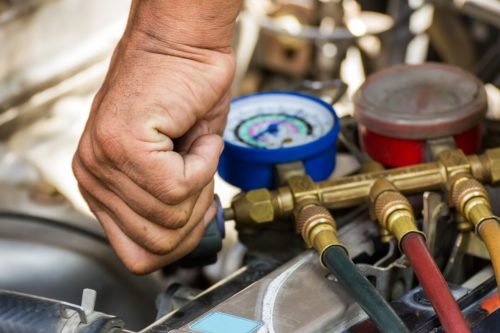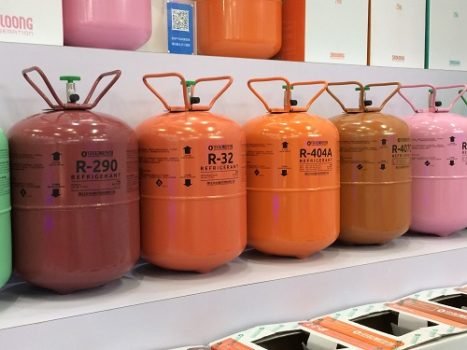Freons
These are colorless gases, odorless, about 4 times heavier than air, harmless. They have no fire and explosive capabilities, but if with the freons contact with open fire, their decomposition is taking place with the formation of a certain amount of toxic phosgene gas. Therefore, it is forbidden to smoke, use open fire in the rooms where there are the freon units.

Freons, in the majority itself, are very fluid, practically do not dissolve in water, they readily dissolve oils, which facilitates the organization of compressors lubrication. They are organic solvents, so ordinary rubber is not suitable for gaskets. For most freons, the mass-specific cooling capacity is much lower than that of ammonia. This means that the sizes and mass of compressors, apparatuses, pipelines in the freon units are significantly higher than in ammonia ones (with identical cooling capacities). However, it also gives and its advantages:
- in small (domestic) refrigerators, this allows the using of compressors with acceptable efficiency, it is more reliable to regulate the cooling capacity in them;
- in large refrigerating machines, it is possible moving quickly to multi-stage centrifugal compressors, which gives significant advantages.

A significant disadvantage of freons − the low heat-transfer coefficients when boiling and condensing. This requires large heat exchange surfaces. Therefore, in freon heat exchangers, as a rule, heat exchange ribbed-tubes are used. And since freons are neutral to all metals, they are usually made of copper alloys. However, each khladon has its own characteristics, which must be taken into account when choosing a working fluid for the refrigerators.
Ammonia - NH3 (R717)
In terms of its thermodynamic properties, it is one of the best refrigerators agents. It is widely used in the compression (mainly in piston and screw) and absorption refrigeration units. Such refrigerating units are used in the food industry, in ice plants, artificial ice-rinks, big fridge iceboxes, fishing trawlers, etc. It needs experienced maintenance personnel for their operations. It is a colorless gas with a stifling smell. It is lighter than air, poisonous. This gas is irritating to the mucous membrane of the eyes and upper respiratory tract. The permissible concentration in the air is not more than 0,02mg/l, the content in the amount of 0.5-1% can lead to a lethal outcome. It has fire and explosive capabilities. It burns at an air concentration of more than 11%, explodes with a retention of 16-26.8% (especially ammonia is dangerous at 22%). Ammonia is readily soluble in water (700 volumes of NH3 vapors in 1 volume of H2O are ammonia). In oil, it dissolves little, it does not change its viscosity, in the pressure pipeline, the oil separators are required. It does not affect ferrous materials, aluminum. Zinc, copper and their alloys (except phosphorus bronze) are destroyed in the presence of water. Ammonia has a high heat transfer coefficient (almost like that of water), which makes it possible to use the ordinary, without ribbing, conductive pipes as the heat transfer elements. A large value of the adiabatic index (k = 1.31) leads to a high injection temperature in the compressor. It is desirable a water cooling of compressors. It is necessary to avoid the overheating of ammonia vapors on the suction line. Ammonia is relatively cheap, chemically stable, common everywhere. It is used wherever toxicity and explosiveness are not the determining factors.
Principle of Refrigerants Selection
From the economic point of view, it is desirable that the refrigerant has such characteristics that would ensure the minimum energy consumption per unit of cooling capacity. However, an analysis of all the refrigerant properties and an operating experience showed that the power consumption per unit of cooling capacity is almost the same for all spread refrigerants.
Therefore, the efficiency and economy are usually not decisive factors in the choice of refrigerant. More important are properties that allow reducing the weight, size and initial cost of the refrigeration equipment, simplify automation and maintenance.
Essential factor − the cost and availability of the refrigerant itself, the requirements for safety.

